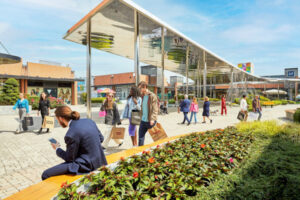PropTech Column by Peter Tonstad
At the time of this writing, Placewise is two weeks away from a beta launch of what we believe is the world’s first fully integrated digital marketplace for a shopping center. It has live product feeds and inventory data from tenants, and consumers can buy across retailers in one consolidated payment and one consolidated delivery or pick-up at the shopping center. This industry-first project has already led to multiple further projects with the same scope, both in Europe and the US. One of them is a new development opening this autumn. In the floor plan, they have allocated floor space in the central area to marketplace fulfilment.
There are more and more examples of partnerships between e-commerce vendors and shopping center owners in terms of fulfilment. In the most extreme examples, the projects include conversions of shopping center properties to become partial warehouses for e-commerce fulfilment.
As we foresee that most shopping centers will also become digital marketplaces over the next ten years, it is obvious that fulfilment options will be an important part of the overall scope. We also believe that shopping centers have many competitive advantages when it comes to fulfilment. Warehouses in general are a bit of a commodity, so purely reallocating floor space for fulfilment purposes might not add value in the longer term. It is in combination with actually having a digital offering from the shopping center for its tenants that makes the fulfilment part really interesting.
Here are some examples of possible scope-related options for fulfilment at shopping centers:
1. Buy online and pick up in store
Individual retailers have been offering in-store pick-up for online purchases for many years, and during the pandemic it has been the only alternative for many retailers who had to operate under restrictions. However, it has already been a very popular way of shopping before the pandemic. Some retailers already reported in 2019 that more than 50 % of all online purchases end up were picked up in stores (e.g., sports chain XXL in the Nordics). In many ways, that is the perfect set-up for retailers; inventory is often readily available in the stores, there are no extra delivery costs, and return rates are very low compared to home delivery (which for some retailers is up to 50 % of all online purchases) as the product is validated in the store and immediately exchanged if needed, which also results in reduced breakage from returns.
This alternative is typically run without any involvement from the shopping center today. With a shopping center marketplace, in-store pick-up and returns are an important part of the overall offering but should be done in combination with other alternatives.
2. Buy online and pick up at centralized pick-up point at shopping center
The added value for consumers of centralized pick-up options at shopping centers is convenience in terms of service and time. This would be a natural part of any digital marketplace offering from a shopping center, either in the form of a serviced pick-up point (or even better a nice pick-up lounge) or by the use of collection boxes. Resources will need to be allocated to run the in-mall fulfilment activities between shopping center team and the stores but is still more cost efficient than home delivery from a retailer perspective and it adds further value to the landlord-tenant relationship. We now also see cases of individual tenants at shopping centers taking on the role of becoming the in-mall fulfilment partner to the benefit of all tenants (maybe as an alternative to down-scaling their floor space).
3. Buy online from the shopping center marketplace for home delivery
Home delivery organized by shopping centers requires the same in-mall capabilities as in te second alternative above, with the extension of partnering with a local/regional/national delivery company. The added value for consumers is getting a multi-store purchase delivered in a single delivery. The added value for the retailers is shared cost on delivery if not all costs are passed on to the consumers.
This alternative also raises the question of why shopping centers should offer home delivery in the first place, as it gives consumers less reasons to come to the mall? The obvious answer is that if the shopping centers do not facilitate and also benefit from home deliveries someone else will, either the retailers directly (as they do today), other online marketplaces (Amazon etc.) or it opens opportunities for market entries for new kinds of competition. Shopping centers have several competitive advantages to facilitate efficient and attractive last-mile deliveries, hence it should be an integrated part of their offering.
4. Conversion of shopping center space to e-commerce warehouses
Many expect that new shopping center developments will include larger warehouse facilities to support e-commerce more than what typically exists today. As to conversion of existing shopping centers to partially become warehouses, it is more of an open question. Shopping center buildings are typically higher standard properties than warehouses, and their locations are usually more prime. So, in financial terms, other alternatives would typically seem more viable for most properties. However, future demand might very well drive this as a requirement for tenants, so maybe a combination of a dedicated remote warehouse connected to an individual shopping center or a cluster of centers will be the solution?
Overall, e-commerce fulfilment will and should be an important part of the future offering of a shopping center. To what extent, will depend on things like location and profile of the center. In any case, shopping centers have the opportunity to become a part of the e-commerce economy and that will deliver great benefits to both shoppers and tenants!





